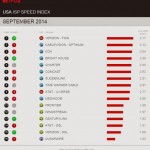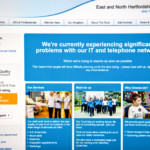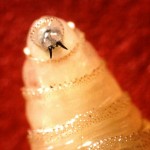Watching two waves of hot lava in the Solar System’s largest volcano
Enlarge / Loki Patera, in the lower-center, has a central island that divides two waves of molten material. (credit: NASA/JPL/USGS ) Volcanic activity appears to be a common feature in our Solar System; we have evidence of it on three planets and two moons and hints of it elsewhere. But that doesn't mean all volcanic activity is the same. Venus' activity is driven by a simple version of plate tectonics. On the Moon, massive lava flows were released by large impacts, and Mars just seems to have vented heat left over from its formation. There are also hints of cryovolcanoes, which belch up ice rather than lava, on some of the bodies of the outer Solar System. But when it comes to sheer volume of activity, all of this takes a back seat to Jupiter's moon Io. Io is partially molten due to gravitational stress from its proximity to three large moons and a massive planet. The results are active volcanoes and vast pools of molten material on the Moon's surface. And we just got a good look inside the biggest of them. Slicing up Loki Loki Patera is the most powerful active volcano in the Solar System. It's an enormous crater with a central island; around that island is a sea of hot material that covers more than 20,000 square kilometers. By all appearances, that hot material isn't stable, since the entire surface seems to be reworked every few years, temporarily replaced by new hot material. Read 10 remaining paragraphs | Comments
Skinny Puppy Wants Compensation For Music Used in US Interrogations
First time accepted submitter time_lords_almanac writes "A Canadian band has sent an invoice to the U.S. Department of Defense after learning that its music was used without permission in 'interrogations' of detainees at Guantanamo Bay. The members of Skinny Puppy, who specialize in electronic music, were originally going to make the invoice the cover of their next album until they discovered they could bring legal action against the department. They were also none to happy to learn the purpose their music was being employed for, let alone illegally. The amount of compensation requested? $666, 000, of course." Read more of this story at Slashdot.
Syrian Electronic Army Claims to Have Taken Over Twitter’s Domain (Updating)
Take this with a grain of salt for now, but the Syrian Electronic Army claims it's taken over Twitter's domain registration. Indeed, several public Whois listings show sea@sea.sy as the contact information for Twitter.com. We've reached out to Twitter, and the company responded that they're "looking into it" Read more...
Since Netflix paid Verizon, video speed on FiOS has doubled
Netflix's payments to Verizon for a direct connection to its network didn't result in immediate improvements for the companies' joint subscribers, but they're finally paying off with better video performance. Verizon FiOS actually topped all other major ISPs in Netflix performance in September with an average stream rate of 3.17Mbps, Netflix said today . Netflix Although Verizon FiOS led all large ISPs in Netflix performance, Google Fiber is still No. 1 among all ISPs regardless of size with a 3.54Mbps average in September. In August, Netflix streamed at an average of 2.41Mbps on Verizon FiOS, ranking tenth out of 16 major ISPs. In July, Netflix speed on Verizon FiOS was 1.61Mbps and in June it was 1.58Mbps, ranking 12th in both months. The Netflix/Verizon deal was announced in late April . When performance continued to get worse after the interconnection agreement, Verizon said it might take until the end of 2014 to get all the proper network connections in place to speed up video. Read 3 remaining paragraphs | Comments
‘WannaCry’ ransomware attack spreads worldwide (update)
England's healthcare system came under a withering cyberattack Friday morning, with " at least 25 " hospitals across the country falling prey to ransomware that locked doctors and employees out of critical systems and networks. The UK government now reports that this is not a (relatively) isolated attack but rather a single front in a massive regionwide digital assault. #nhscyberattack pic.twitter.com/SovgQejl3X — gigi.h (@fendifille) May 12, 2017 The attack has impacted hospitals and transportation infrastructure across Europe, Russia and Asia. Organizations in dozens of countries have all been hit with the same ransomware program, a variant of the WannaCry virus, spouting the same ransom note and demanding $300 for the encryption key, with the demand escalating as time passes. The virus's infection vector appears to through a known vulnerability, originally exploited and developed by the National Security Agency. That information was subsequently leaked by the hacking group known as Shadow Broker which has been dumping its cache of purloined NSA hacking tools onto the internet since last year. The virus appears to have originally spread via email as compressed file attachment so, like last week's Google Docs issue, make sure you confirm that you email's attachments are legit before clicking on them. Also, make sure your computers are using software that's still receiving security updates, and that you've installed the latest updates available. Microsoft released a fix for the exploit used as a part of its March "Patch Tuesday" release, but unpatched Windows systems remain vulnerable. Update : Reuters reports a statement from Microsoft indicating that engineers have added detection and protection against the "Ransom:Win32.WannaCrypt" malware, so make sure your Windows Defender or other antivirus is updated before logging on to any corporate networks that may be infected. In a statement, a FedEx representative confirmed its systems are being impacted, saying "Like many other companies, FedEx is experiencing interference with some of our Windows-based systems caused by malware. We are implementing remediation steps as quickly as possible. We regret any inconvenience to our customers." Source: New York Times
New ultra-high resolution printer makes colors from nanostructures
Researchers from the Technical University of Denmark demonstrated a new nanotechnology-based printing technique that produces long-lasting color images on plastic at resolutions up to 127,000 dots per inch, many times more detailed than traditional laser printers. The system uses a laser to alter the structure of nanoscale structures on the plastic material. (A nanometer is one-billionth of a meter; a human hair is around 60,000 nanometers in diameter.) The nanoprinting technique could also lead to new kinds of 3D displays or invisible watermarks. From New Scientist : The surface of the plastic is shaped so that it has lots of tiny pillars, one roughly every 200 nanometers. A thin film of the element germanium is then spread over the plastic. Heat from a laser melts the germanium on each pillar, morphing its shape and thickness. As a result, it reflects a specific color. The coating protects the shapes of the newly carved nanostructures. Resonant laser printing of structural colors on high-index dielectric metasurfaces (ScienceAdvances)
This Synthetic Bone Implant Could Replace Painful Marrow Transplants
Thanks to advances in medicine, bone marrow transplants are no longer the last resorts they one were. Every year, thousands of marrow transplants are performed, a common treatment for ailments from bone marrow disease to leukemia. But because they first require a patient undergo radiation to kill off any existing bone… Read more...
Gmail’s Getting a Neat Freak Overhaul for Web and Mobile
Google just announced a new interface for you Gmail based around customizable tabs. The goal? To you help manage your goliath of an inbox. It looks pretty incredible. Read more...
State of emergency declared as Florida struck by flesh-eating screwworms
Nice place! Via PBS : The discovery occurred earlier this month in the Florida Keys, where the U.S. Department of Agriculture detected the New World screwworm, a parasite that lives inside open wounds, in a deer. About 30 deer have been found dead or been euthanized in the last two weeks due to screwworm infections. As a result, the county declared an agricultural state of emergency. “The screwworm is a potentially devastating animal disease that sends shivers down every ranchers spine,” Florida Commissioner of Agriculture Adam Putnam said. “It’s been more than five decades since the screwworm infested Florida, and I’ve grown up hearing the horror stories from the last occurrence.”
235 apps attempt to secretly track users with ultrasonic audio
Ultrasonic beacons ( previously , previously ) let advertisers build an idea of when and where you use your devices: the sound plays in an ad on one device, and is heard by other devices. This way, they can associate two gadgets with a single user, precisely geolocate devices without aGPS, or even build graphs of real-world social networks. The threat was considered more academic than some, but more than 200 Android apps were found in the wild using the technique . In research sponsored by the German government [PDF], a team of researchers conducted extensive tests across the EU to better understand how widespread this practice is in the real world. Their results revealed Shopkick ultrasonic beacons at 4 of 35 stores in two European cities. The situation isn't that worrisome, as users have to open an app with the Shopkick SDK for the beacon to be picked up. In the real world, this isn't an issue, as store owners, advertisers, or product manufactures could incentivize users to open various apps as a way to get discounts. From the paper: While in April 2015 only six instances were known, we have been able to identify 39 further instances in a dataset of about 1,3 million applications in December 2015, and until now, a total of 234 samples containing SilverPush has been discovered. We conclude that even if the tracking through TV content is not actively used yet, the monitoring functionality is already deployed in mobile applications and might become a serious privacy threat in the near future Apparently it's not very effective—consumer speakers and mics aren't designed with ultrasonic use in mind and the authors say noise, audio compression and other factors "significantly affects the feasibility" of the technology—but the intent is clearly there on the part of advertisers and appmakers to make a stab at it. Annoyingly, there doesn't seem to be a list of the apps that are doing this, but there is a reference to a McDonalds app. If an app asks for access to your device's microphone, camera, etc., and you don't know why, delete the app.














